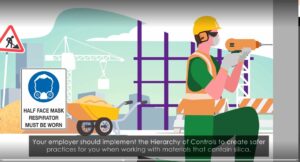This animation was developed as part of the National Silicosis Prevention and Awareness Campaign that Lung Foundation Australia runs annually. This is a short animation about the Hierarchy of Controls. The video talks about each control measure and how it can be used to reduce exposure to silica dust in the workplace. Silica dust is a hazardous airborne substance generated when materials containing crystalline silica—such as soil, sand, granite, and engineered stone—are cut, drilled, ground, or disturbed.
Currently, nearly 600,000 Australian workers are exposed to silica dust, making education and prevention critical. Silica is found in a wide range of materials, with varying concentrations:
- Engineered Stone: Up to 97% silica
- Natural Sandstone: 70–95%
- Granite: 20–45%
- Shale: 22%
- Slate: 25–40%
- Limestone and Marble: Around 2%
Common work activities that generate silica dust include excavation, earthmoving, paving, surfacing, and cutting or drilling stone, brick, and concrete—especially when performed dry. These tasks release fine silica particles into the air, which can be easily inhaled.
The Hierarchy of Control consists of six levels, and are ranked based on their effectiveness to control the hazard. Below is a summary of the control measures covered in the short animation:
- Elimination is the most effective and means the removal of a hazard
- Substitution is next which reflects the using of a safter material
- Isolation requires the separation of people from the hazard
- Engineering controls follows and is the redesign or modifying of equipment
- Administrative controls is the implementing of training and procedures
- Personal Protective Equipment (PPE) is on the bottom of the Hierarchy of Controls and requires the use of fit-for-purpose PPE
- It is important to remember that PPE is on the bottom of the hierarchy and should not solely be relied upon to protect workers from hazards.
To learn more about occuaptional hazards, occupational lung disease to what support is available visit Lung Foundation Australia’s website.
Was this page helpful?
Good job! Please give your positive feedback
How could we improve this post? Please Help us.
